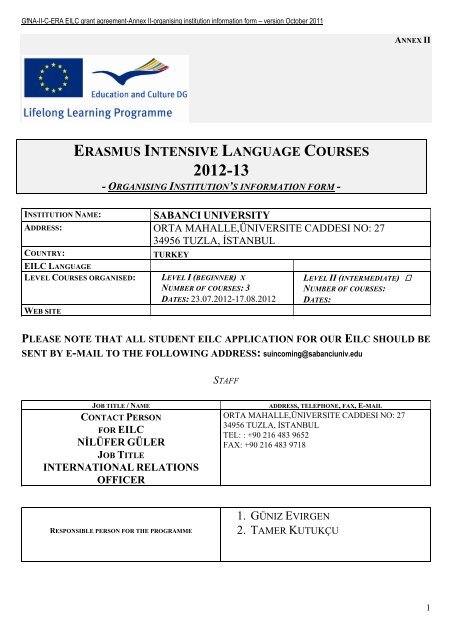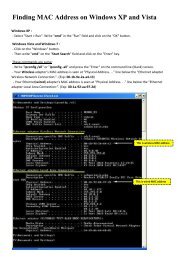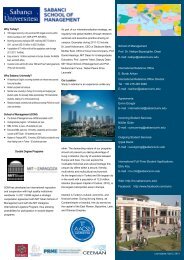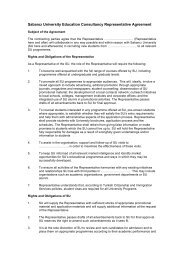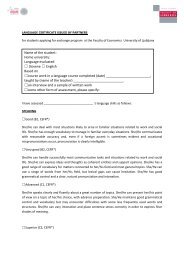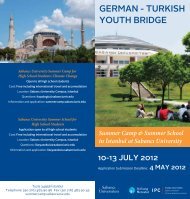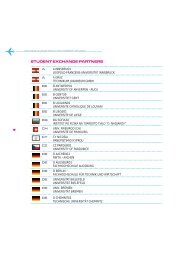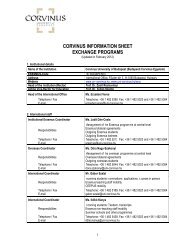ERASMUS INTENSIVE LANGUAGE COURSES - Sabanci University
ERASMUS INTENSIVE LANGUAGE COURSES - Sabanci University
ERASMUS INTENSIVE LANGUAGE COURSES - Sabanci University
You also want an ePaper? Increase the reach of your titles
YUMPU automatically turns print PDFs into web optimized ePapers that Google loves.
GfNA-II-C-ERA EILC grant agreement-Annex II-organising institution information form – version October 2011<br />
ANNEX II<br />
<strong>ERASMUS</strong> <strong>INTENSIVE</strong> <strong>LANGUAGE</strong> <strong>COURSES</strong><br />
2012-13<br />
- ORGANISING INSTITUTION’S INFORMATION FORM -<br />
INSTITUTION NAME: SABANCI UNIVERSITY<br />
ADDRESS: ORTA MAHALLE,ÜNIVERSITE CADDESI NO: 27<br />
34956 TUZLA, İSTANBUL<br />
COUNTRY:<br />
TURKEY<br />
EILC <strong>LANGUAGE</strong><br />
LEVEL <strong>COURSES</strong> ORGANISED:<br />
WEB SITE<br />
LEVEL I (BEGINNER) X<br />
NUMBER OF <strong>COURSES</strong>: 3<br />
DATES: 23.07.2012-17.08.2012<br />
<br />
LEVEL II (INTERMEDIATE) <br />
NUMBER OF <strong>COURSES</strong>:<br />
DATES:<br />
<br />
PLEASE NOTE THAT ALL STUDENT EILC APPLICATION FOR OUR EILC SHOULD BE<br />
SENT BY E-MAIL TO THE FOLLOWING ADDRESS: suincoming@sabanciuniv.edu<br />
STAFF<br />
JOB TITLE / NAME<br />
CONTACT PERSON<br />
FOR EILC<br />
NİLÜFER GÜLER<br />
JOB TITLE<br />
INTERNATIONAL RELATIONS<br />
OFFICER<br />
ADDRESS, TELEPHONE, FAX, E-MAIL<br />
ORTA MAHALLE,ÜNIVERSITE CADDESI NO: 27<br />
34956 TUZLA, İSTANBUL<br />
TEL: : +90 216 483 9652<br />
FAX: +90 216 483 9718<br />
RESPONSIBLE PERSON FOR THE PROGRAMME<br />
1. GÜNIZ EVIRGEN<br />
2. TAMER KUTUKÇU<br />
1
GfNA-II-C-ERA EILC grant agreement-Annex II-organising institution information form – version October 2011<br />
PART I: GENERAL INFORMATION<br />
DESCRIPTION OF TOWN<br />
- SHORT HISTORY AND LOCATION<br />
Istanbul's dual identity as point of origin for Europe and Asia is due to the city's east-west borders as well<br />
as its shorelines on the Black Sea looking towards to the north, and the Bosphorus' southern waters flowing to<br />
the Sea of Marmara. Central to Istanbul is the Bosphorus, dividing the city into two. This important waterway<br />
has served as the pathway for all trade passing through the city for thousands of years. The only way to reach<br />
the open seas of the Aegean and the Mediterranean from the East is to navigate the turbulent waters of the<br />
Bosphorus. The strait has an approximate 31 km length with an average width of 1.5 km. The strait's<br />
narrowest part is between Anadolu Hisari and Rumeli Hisari having a width of 698 m.<br />
Traces of communal settlements on the European side by the shores of Kucukcekmece Lake can be found<br />
as far back as 300,000 years, and tools dating from the Lower Palaeolithic Age (around 100,000 years ago)<br />
have been discovered on the Asian coastline. Kadikoy, another suburb of the Asian side, was also the site of<br />
an important culture at around 5000 B.C.<br />
Kadikoy forms also the foundations of what is now called Istanbul. In 700 B.C., Greek pioneers from the<br />
city of Megara from the mainland and from Miletus, on the Anatolian coast of the southern Aegean,<br />
established the town of Chalcedon in the area of today's Kadikoy. On the opposite side of the Bosphorus,<br />
Greek colonists led by King Byzas created the colony of Byzantium, based on the Oracle of Delphi which<br />
suggested that earlier settlements were 'blind' to the attractive location at the mouth of Bosphorus Strait. In 306<br />
Constantine the Great made Byzantium the capital of the Roman Empire, and the city served as a loci for trade<br />
and transport among three continents. What made Byzantium so desirable also contributed to its downfall:<br />
Persians, Arabs, raiders from the north, and Crusaders all attacked the wealthy city. In 1457 Byzantium finally<br />
succumbed to the Ottomans under Sultan Mehmet the Conqueror. The Ottoman Empire lasted until its defeat<br />
along with its allies at the end of World War I. Istanbul saw its shores invaded in 1918 by the Allies; however,<br />
five years later, in 1923, the city was incorporated into the Turkish Republic.<br />
When enjoying the sunset on the shores of the Bosphorus, visitors and inhabitants alike realize why so<br />
many centuries ago settlers chose this remarkable site.<br />
- MAIN LOCAL/CULTURAL EVENTS<br />
Istanbul's museums, churches, mosques, palaces, and many other areas of interest offer a rich cultural and<br />
historical experience to all. The possibilities are endless. The cultural heritage, which is a well essence of<br />
300.000 years and many civilizations, can be viewed from streets to museums, from residences to bazaars.<br />
2
GfNA-II-C-ERA EILC grant agreement-Annex II-organising institution information form – version October 2011<br />
Moreover, Istanbul's large youth population (currently 50% of the population is under 40) and recent<br />
economic prosperity have enriched its already diverse nightlife. The range of night entertainment is huge:<br />
traditional pubs/taverna to techno and rave nightclubs, with new venues opening weekly. As a result, Istanbul's<br />
nightlife is quickly gaining recognition as one of the liveliest in Europe. Many international classical music,<br />
opera, and ballet as well as rock groups include the city on their tours. Beyoglu district, for example, is the<br />
center of casual, inexpensive, and youthful entertainment. At the 'pricey' end of spectrum are bars and clubs<br />
catering to the Turkey's elite powerful families, artists, and intellectuals. These superbly stylish watering holes<br />
are located throughout Istanbul. They can be found, for example, in the neighborhoods of Ulus, Ortakoy,<br />
Bebek, Cubuklu, and Macka.<br />
- HOW TO REACH TOWN (LINKS FROM THE NEAREST AIRPORT, TRAIN OR COACH STATIONS)<br />
There are two international airports in Istanbul. The biggest and the most used one is called Ataturk<br />
International Airport and it is located at Yesilkoy district on the European side of Istanbul. The other airport,<br />
Sabiha Gokcen International Airport, is located on the Asian side of Istanbul. Sabiha Gokcen Airport is 20<br />
minutes drive away from the Sabancı <strong>University</strong> Campus, and there are many charter flights from Europe<br />
arriving at Sabiha Gokcen. All exchange students coming to Turkey through Ataturk International Airport are<br />
recommended to take the airport shuttle service to Taksim. The road takes approximately 40 minutes. Taksim<br />
is the central area of the European side of the city. Therefore, there are regular <strong>University</strong> shuttles departing<br />
from Taksim to Campus.<br />
- TRANSPORT IN TOWN (BRIEF INFORMATION ON THE MAIN MEANS OF TRANSPORT AVAILABLE)<br />
Public transport in Istanbul comprises an extensive bus network, various rail systems, funiculars, and maritime<br />
services to go from the asian to the European side and viceversa. Once downtown, transportation is carried on<br />
buses, metro and minibuses. The main entrance to the <strong>University</strong> can be reached via the access roads after the<br />
Pendik-Kurtkoy or Cayirova-Bayramoglu exit. The campus is 45 minutes by car from downtown city of<br />
Istanbul. The <strong>University</strong> is connected to the several centers at downtown by regular shuttle services.<br />
3
GfNA-II-C-ERA EILC grant agreement-Annex II-organising institution information form – version October 2011<br />
SHORT DESCRIPTION OF THE ORGANISING INSTITUTION<br />
With science, technology, and social structures advancing day by day, the world needs more qualified<br />
individuals who possess the knowledge and skills required to pursue a career anywhere in the world. Aware<br />
of this pressing issue, in 1994 the <strong>Sabanci</strong> Group decided to establish a "world university" led by the Sabancı<br />
Foundation.<br />
The seeds of Sabancı <strong>University</strong> (SU) were sown in the summer of 1995, at a search conference in which<br />
50 academics from 22 countries as well as students and representatives from the private sector participated.<br />
While still very young the university has built an excellent reputation worldwide. SU hosts every year close<br />
to 150 international students, totaling 4 % of the student body.<br />
ACCOMMODATION<br />
- SHORT DESCRIPTION OF THE ACCOMMODATION OFFERED (HOTEL, APARTMENTS, STUDENT HALLS, OTHERS; IF THERE ARE<br />
COOKING FACILITIES) AND ON THE RENT TO BE PAID PER WEEK<br />
All EILC students are guaranteed accommodation in our dorms. Dorm rooms, which accommodate 2 or 1<br />
exchange student, are equipped with showers, closets, and personal telephones. Automatic washing machines,<br />
driers and irons are for free in the laundry rooms in the dorm buildings. A private cleaning staff member<br />
ensures that the housings and all shared common spaces maintain a high level of hygiene.<br />
MEALS<br />
- SHORT DESCRIPTION ON THE SERVICES OFFERED (UNIVERSITY CANTEENS, RESTAURANTS, BARS, OTHERS)<br />
Sabancı <strong>University</strong> provides spacious, clean and qualified food alternatives.<br />
A food hall with a capacity of 900 people is available in the <strong>University</strong> Centre. Here breakfast, lunch and<br />
dinner are served. The menu consists of a various selections and also table d'hote menu is served as an<br />
option. The daily menu is announced on the local web site to make the food selection more convenient.<br />
Students may benefit, in a more economical way, from the card system designed for them in the <strong>University</strong><br />
Centre main food hall. You can buy the cards at the second floor of the <strong>University</strong> Center when the semester<br />
starts.<br />
In the fast food café located on the upper level of the main cafeteria various food alternatives from daily<br />
patisserie products to burgers, sandwich varieties and salad bar are also available.<br />
At the dormitory area, around the pool, 3 different cafés serve a variety ranging from grills, sandwiches,<br />
salads, deserts, hot and cold beverages. Other than these, in various faculty buildings within the <strong>University</strong>,<br />
vending machines provide cold drinks 24 hours. There are vending machines in the dorms and faculty<br />
buildings. The average monthly dining cost is 450 TL<br />
4
GfNA-II-C-ERA EILC grant agreement-Annex II-organising institution information form – version October 2011<br />
RECEPTION OF STUDENTS<br />
- MEETING POINT (PLACE, DATE AND TIME OF FIRST MEETING - FOR EACH COURSE WHERE DIFFERENT)<br />
All students will meet on the first day of class at the entrance of School of Languages. The International<br />
Relations Office will assist students during the first days and will provide them with an introductory<br />
information package and course materials.<br />
EXTRA MURAL ACTIVITIES<br />
- SITE VISITS<br />
The city tours to 1) The Blue Mosque - Hagia Sophia - Basilica cistern - The Grand Bazaar and 2) Bosporus or<br />
Islands. The routes may be changed according to the students’ requests. The tours will be organized by the<br />
students with the assistance and monitoring of instructors, IRO staff and local students.<br />
- SPORTS FACILITIES (SWIMMING, TENNIS, GYMNASIUM; OPENING DAYS AND AVAILABLE INFORMATION)<br />
The various sports facilities on campus, open to all university members,consist of:<br />
_ a multi-purpose sports hall with tennis court and basketball field<br />
_ a football field<br />
_ fitness programs such as aerobic, step, and jogging<br />
_ table tennis rooms<br />
_ a conditioning room<br />
_ open and illuminated fields suitable for playing basketball, volleyball, and<br />
soccer.<br />
_ The Main Sports Center includes squash courts, basketball, volleyball fields, handball, bodybuilding as well<br />
as cardio-exercise and aerobic rooms.<br />
5
GfNA-II-C-ERA EILC grant agreement-Annex II-organising institution information form – version October 2011<br />
fields, handball, bodybuilding as well as cardio-exercise and aerobic rooms.<br />
- ENTERTAINMENT (CINEMA, THEATRE, ETC.; BRIEF INFORMATION ON PLACES AND STUDENT FACILITIES)<br />
Culture at SU is very important. We have the largest performing arts center on the Asian side of Istanbul.<br />
Every month at least nine performances span the entire spectrum of classical music, theaters, rock concerts,<br />
debates, ballet and many more. We offer regular busses to the city centers, Taksim on the European Side and<br />
Kadıköy on the Asian side. A large outlet mall with around 200 stores is located within a few minutes with a<br />
free shuttle service.<br />
6
Note: where more than one course is organised at each level, this form should be copied and<br />
completed for each course<br />
COURSE NO:<br />
LEVEL:<br />
I: Beginner course<br />
II: Intermediate course<br />
PART II: COURSE(S) DESCRIPTION<br />
FROM...<br />
PERIOD: 23.07.2012 17.08.2012<br />
TO...<br />
<strong>LANGUAGE</strong> COMPONENT<br />
- SHORT DESCRIPTION OF <strong>LANGUAGE</strong> COMPONENT: OBJECTIVES AND TEACHING METHODS<br />
In terms of learning outcomes, the course aims to help students develop the following knowledge, skills and<br />
strategies:<br />
* developing a repertoire of basic language to deal with predictable classroom situations; giving short<br />
descriptions and making simple claims on factual topics<br />
* reading extracts from simple coherent texts on familiar topics consisting of mainly high frequency<br />
vocabulary<br />
* writing simple connected texts with reference to knowledge from previously read or heard texts, consisting<br />
of a series of phrases and simple sentences<br />
* understanding the main ideas in standard speech, provided it is clearly articulated and the speaker is<br />
sympathetic to the language ability of the listener<br />
* interacting with reasonable ease in structured situations and short conversations, provided the other person<br />
helps if necessary; giving simple descriptions about a familiar topic<br />
* making short contributions to discussions which are conducted in clearly articulated speech; exchanging<br />
factual information on familiar topics and making simple claims when asked directly; making and responding<br />
to suggestions; agreeing and disagreeing with others<br />
* relaying straightforward factual information; giving a description or relate events as a simple list of points<br />
In the course language is viewed as communication and an integrated approach to the teaching of language is<br />
taken rather than teaching them separately and in isolation. The learner is at the heart of instruction with<br />
methods and techniques built around student-centered teaching and more importantly on principles which<br />
view learners as individuals with vast potential and a rich repertoire of learning styles and strategies, which<br />
learners may or may not be aware of.<br />
- SUBJECT-SPECIFIC <strong>LANGUAGE</strong> ELEMENTS YES X NO<br />
(e.g. special modules for students in particular disciplines)<br />
IF YES, SPECIFY:<br />
7
Note: where more than one course is organised at each level, this form should be copied and<br />
completed for each course<br />
- DURATION<br />
TOTAL NUMBER OF CLASSES 64 h.<br />
HOURS IN CLASSROOM 40h.<br />
HOURS OF PRACTICE CONVERSATION/<strong>LANGUAGE</strong> LABORATORY 24h.<br />
OTHER (PLEASE SPECIFY)<br />
4 HOURS A DAY, 16 HOURS A WEEK, 64 CLASS HOURS IN TOTAL FOR EACH SECTION<br />
- ASSESSMENT (SPECIFY IF THE ASSESSMENT IS MADE BY WRITTEN/ORAL EXAMINATION, ASSIGNMENT, ETC.)<br />
Students will be assessed through formative assessment methods. The students are expected to take 2 exams,<br />
towards the end of the 2nd and 4th weeks. Besides this, 3 assignments of various types will be arranged a quiz,<br />
homework and/or an oral assessment.<br />
COURSE FACILITIES<br />
- TEACHING AIDS<br />
AUDIO/VIDEO MATERIALS – YES<br />
COMPUTER/SOFTWARE – YES<br />
HANDOUTS/PRINTED TEXTS – YES<br />
TRANSPARENCIES<br />
OTHER : (SPECIFY)<br />
- LIBRARY YES NO <br />
IF YES, SPECIFY:<br />
TIMES<br />
OPENING DAYS<br />
ADDRESS<br />
- <strong>LANGUAGE</strong> LABORATORY YES NO <br />
IF YES, SPECIFY:<br />
TIMES<br />
OPENING DAYS<br />
ADDRESS<br />
COST<br />
CULTURAL COMPONENT<br />
- SHORT DESCRIPTION OF THE CULTURAL ELEMENTS INCLUDED IN THE COURSE: OBJECTIVES AND TEACHING METHODS<br />
8
Note: where more than one course is organised at each level, this form should be copied and<br />
completed for each course<br />
CULTURAL ELEMENTS HAVE HUMANIZING AND MOTIVATING EFFECT ON THE LEARNERS, HELP THEM TO OBSERVE SIMILARITIES AND<br />
DIFFERENCES AMONG VARIOUS CULTURAL GROUPS. THE ELEMENTS ALSO PLAY AN IMPORTANT ROLE IN GENERAL CULTURE, SINCE<br />
MAKING A RESEARCH ABOUT THE CULTURE OF A COUNTRY WE ALSO LEARN ABOUT ITS GEOGRAPHY, HISTORY AND TRADITIONS.<br />
IN THE PROGRAM WE PROVIDE CULTURAL ELEMENTS ARE PRESENTED AS AN INTERDISIPLINARY CORE OF THE TEACHING/LEARNING<br />
PROCESS, HELPING LEARNERS TO RELATE THE ABSTRACT RULES AND STRUCTURES TO THE REAL SOCIETY AND LIFE STYLE. BEING<br />
CONTENT-BASED, ALL KIND OF TEACHING MATERIAL AND ACTIVITIES CONTAIN GENUINE EXAMPLES FROM REAL LIFE, AIMING TO<br />
INTRODUCE THE NEW CULTURAL ENVIROMENT TO THE LEARNERS AND RAISE THEIR CULTURAL AWARENESS RELATED TO BOTH NATIVE<br />
AND TARGET SOCIETIES. BESIDES THESE CHARACTERISTICS, WE PRESENT THE SERIAL OF SEMINARS TWICE A WEEK, WHERE LEARNERS<br />
HAVE AN OPPORTUNITY TO GET ASQUAINTANCE WITH THE VARIOUS CULTURAL AND HISTORICAL ASPECTS OF TURKISH SOCIETY.<br />
AUDIO- AND VIDEO AIDS SUPPORT THE EFFECTIVENESS OF THE SEMINARS, DISCUSSIONS GIVE LEARNERS THE CHANCE TO EXPRESS<br />
THEIR IDEAS, SEE THE TOPICS VIA DIFFERENT WAYS OF LOOKING. TOURS TO THE BOSPORUS AND HISTORICAL PENINSULA HELP THEM TO<br />
MAINTAIN THE CONNECTIONS BETWEEN IN-CLASS WORK AND THE REALITY OF THE OUTSIDE WORLD.<br />
- DURATION 1HOUR<br />
TOTAL HOURS OF ACTIVITIES 8h.<br />
TEACHERS AND SUPPORT STAFF<br />
TEACHERS<br />
2<br />
ADMINISTRATORS<br />
1<br />
STUDENTS<br />
1<br />
NUMBER OF...:<br />
9


